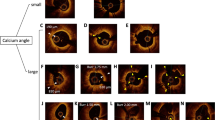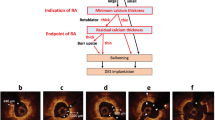Abstract
We aimed to evaluate the optical frequency-domain imaging (OFDI) findings after rotational atherectomy (RA) that predict good stent expansion for severely calcified coronary lesions. Fifty consecutive calcified lesions were subjected to RA under OFDI guidance. We performed OFDI just after RA and stenting. We measured the morphology of calcium after RA, and assessed how these factors influence stent expansion. The stent expansion index was defined as the minimum stent area divided by the average of the proximal and distal reference lumen areas. Minimum thickness of calcification in the intima after RA showed a significant negative correlation with stent expansion (r = − 0.53, P < 0.001), while calcium arc, length, and maximum thickness of calcification in the intima did not. Dissection after RA occurred in 22 lesions (44%), and the stent expansion index was significantly better in dissected lesions than in lesions without dissection (0.96 ± 0.08 vs. 0.82 ± 0.19, P = 0.002). Multiple regression analysis showed that the minimum thickness of calcification in the intima (standardized coefficient: − 0.451, P < 0.001) and dissection formation (standardized coefficient: 0.316, P = 0.011) were predictors of good stent expansion. Minimum of thickness of calcification in the intima and dissection formation were positively associated with good stent expansion after RA. In the clinical setting, achieving these two endpoints should be the aim of RA to ensure good stent expansion.





Similar content being viewed by others
References
Stone GW, Teirstein PS, Meredith IT, Farah B, Dubois CL, Feldman RL, Dens J, Hagiwara N, Allocco DJ, Dawkins KD (2011) A prospective, randomized evaluation of a novel everolimus-eluting coronary stent: the PLATINUM (a prospective, randomized, multicenter trial to assess an everolimus-eluting coronary stent system [PROMUS element] for the treatment of up to two de novo coronary artery lesions) trial. J Am Coll Cardiol 57(16):1700–1708. https://doi.org/10.1016/j.jacc.2011.02.016
Saito S, Valdes-Chavarri M, Richardt G, Moreno R, Iniguez Romo A, Barbato E, Carrie D, Ando K, Merkely B, Kornowski R, Eltchaninoff H, James S, Wijns W, Investigators CI (2014) A randomized, prospective, intercontinental evaluation of a bioresorbable polymer sirolimus-eluting coronary stent system: the CENTURY II (clinical evaluation of new terumo drug-eluting coronary stent system in the treatment of patients with coronary artery disease) trial. Eur Heart J 35(30):2021–2031. https://doi.org/10.1093/eurheartj/ehu210
Kereiakes DJ, Meredith IT, Windecker S, Lee Jobe R, Mehta SR, Sarembock IJ, Feldman RL, Stein B, Dubois C, Grady T, Saito S, Kimura T, Christen T, Allocco DJ, Dawkins KD (2015) Efficacy and safety of a novel bioabsorbable polymer-coated, everolimus-eluting coronary stent: the EVOLVE II Randomized Trial. Circ Cardiovasc Interv. https://doi.org/10.1161/CIRCINTERVENTIONS.114.002372
Fujii K, Carlier SG, Mintz GS, Yang YM, Moussa I, Weisz G, Dangas G, Mehran R, Lansky AJ, Kreps EM, Collins M, Stone GW, Moses JW, Leon MB (2005) Stent underexpansion and residual reference segment stenosis are related to stent thrombosis after sirolimus-eluting stent implantation: an intravascular ultrasound study. J Am Coll Cardiol 45(7):995–998. https://doi.org/10.1016/j.jacc.2004.12.066
Kawamoto H, Latib A, Ruparelia N, Ielasi A, D’Ascenzo F, Pennacchi M, Sardella G, Garbo R, Meliga E, Moretti C, Rossi ML, Presbitero P, Magri CJ, Nakamura S, Colombo A, Boccuzzi GG (2016) In-hospital and midterm clinical outcomes of rotational atherectomy followed by stent implantation: the ROTATE multicentre registry. EuroIntervention 12(12):1448–1456. https://doi.org/10.4244/eij-d-16-00386
Eftychiou C, Barmby DS, Wilson SJ, Ubaid S, Markwick AJ, Makri L, Blaxill JM, Spratt JC, Gunning M, Greenwood JP (2016) Cardiovascular outcomes following rotational atherectomy: a UK multicentre experience. Catheter Cardiovasc Interv 88(4):546–553. https://doi.org/10.1002/ccd.26587
Iannaccone M, Piazza F, Boccuzzi GG, D’Ascenzo F, Latib A, Pennacchi M, Rossi ML, Ugo F, Meliga E, Kawamoto H, Moretti C, Ielasi A, Garbo R, Frangieh AH, Hildick-Smith D, Templin C, Colombo A, Sardella G (2016) ROTational AThErectomy in acute coronary syndrome: early and midterm outcomes from a multicentre registry. EuroIntervention 12(12):1457–1464. https://doi.org/10.4244/eij-d-15-00485
Azzalini L, Dautov R, Ojeda S, Serra A, Benincasa S, Bellini B, Giannini F, Chavarria J, Gheorghe LL, Pan M, Carlino M, Colombo A, Rinfret S (2017) Long-term outcomes of rotational atherectomy for the percutaneous treatment of chronic total occlusions. Catheter Cardiovasc Interv 89(5):820–828. https://doi.org/10.1002/ccd.26829
Kume T, Okura H, Kawamoto T, Yamada R, Miyamoto Y, Hayashida A, Watanabe N, Neishi Y, Sadahira Y, Akasaka T, Yoshida K (2011) Assessment of the coronary calcification by optical coherence tomography. EuroIntervention 6(6):768–772. https://doi.org/10.4244/eijv6i6a130
Cohen BM, Weber VJ, Blum RR, Ruck BE, Cohen DE, Haik BJ, Coletti RH (1996) Cocktail attenuation of rotational ablation flow effects (CARAFE) study: pilot. Catheter Cardiovasc Diagn Suppl 3:69–72
Yabushita H, Bouma BE, Houser SL, Aretz HT, Jang IK, Schlendorf KH, Kauffman CR, Shishkov M, Kang DH, Halpern EF, Tearney GJ (2002) Characterization of human atherosclerosis by optical coherence tomography. Circulation 106(13):1640–1645
Maejima N, Hibi K, Saka K, Akiyama E, Konishi M, Endo M, Iwahashi N, Tsukahara K, Kosuge M, Ebina T, Umemura S, Kimura K (2016) Relationship between thickness of calcium on optical coherence tomography and crack formation after balloon dilatation in calcified plaque requiring rotational atherectomy. Circ J 80(6):1413–1419. https://doi.org/10.1253/circj.CJ-15-1059
Kini AS, Vengrenyuk Y, Pena J, Motoyama S, Feig JE, Meelu OA, Rajamanickam A, Bhat AM, Panwar S, Baber U, Sharma SK (2015) Optical coherence tomography assessment of the mechanistic effects of rotational and orbital atherectomy in severely calcified coronary lesions. Catheter Cardiovasc Interv 86(6):1024–1032. https://doi.org/10.1002/ccd.26000
Kubo T, Shimamura K, Ino Y, Yamaguchi T, Matsuo Y, Shiono Y, Taruya A, Nishiguchi T, Shimokado A, Teraguchi I, Orii M, Yamano T, Tanimoto T, Kitabata H, Hirata K, Tanaka A, Akasaka T (2015) Superficial calcium fracture after PCI as Assessed by OCT. JACC Cardiovasc Imaging 8(10):1228–1229. https://doi.org/10.1016/j.jcmg.2014.11.012
Kobayashi Y, Okura H, Kume T, Yamada R, Kobayashi Y, Fukuhara K, Koyama T, Nezuo S, Neishi Y, Hayashida A, Kawamoto T, Yoshida K (2014) Impact of target lesion coronary calcification on stent expansion. Circ J 78(9):2209–2214
Safian RD, Feldman T, Muller DW, Mason D, Schreiber T, Haik B, Mooney M, O’Neill WW (2001) Coronary angioplasty and Rotablator atherectomy trial (CARAT): immediate and late results of a prospective multicenter randomized trial. Catheter Cardiovasc Interv 53(2):213–220. https://doi.org/10.1002/ccd.1151
Whitlow PL, Bass TA, Kipperman RM, Sharaf BL, Ho KK, Cutlip DE, Zhang Y, Kuntz RE, Williams DO, Lasorda DM, Moses JW, Cowley MJ, Eccleston DS, Horrigan MC, Bersin RM, Ramee SR, Feldman T (2001) Results of the study to determine rotablator and transluminal angioplasty strategy (STRATAS). Am J Cardiol 87(6):699–705
Author information
Authors and Affiliations
Corresponding author
Ethics declarations
Conflict of interest
The authors declare that they have no financial relationships or other conflict of interest relevant to the contents of this paper.
Ethical approval
All procedures performed in studies involving human participants were in accordance with the ethical standards of the institutional and/or national research committee and with the 1964 Helsinki declaration and its later amendments or comparable ethical standards.
Informed consent
Informed consent was obtained from all individual participants included in the study.
Rights and permissions
About this article
Cite this article
Kobayashi, N., Ito, Y., Yamawaki, M. et al. Optical frequency-domain imaging findings to predict good stent expansion after rotational atherectomy for severely calcified coronary lesions. Int J Cardiovasc Imaging 34, 867–874 (2018). https://doi.org/10.1007/s10554-018-1300-x
Received:
Accepted:
Published:
Issue Date:
DOI: https://doi.org/10.1007/s10554-018-1300-x




